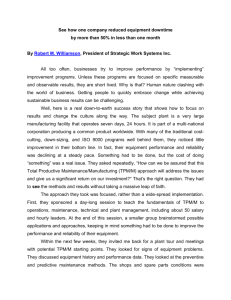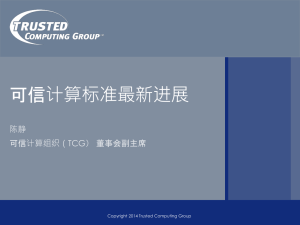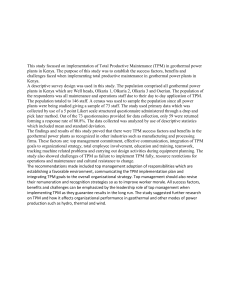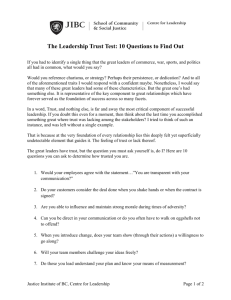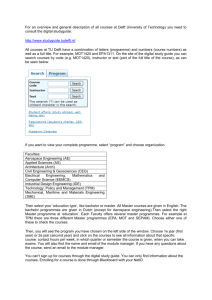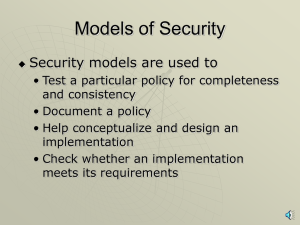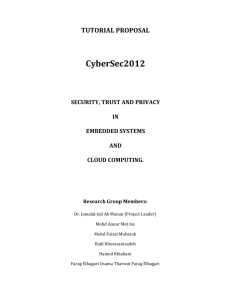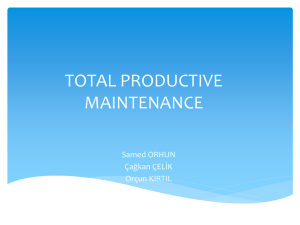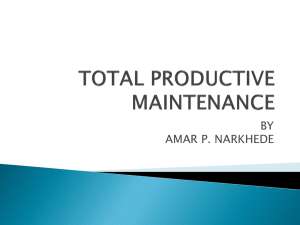Trusted Platform Module - COSIC
advertisement
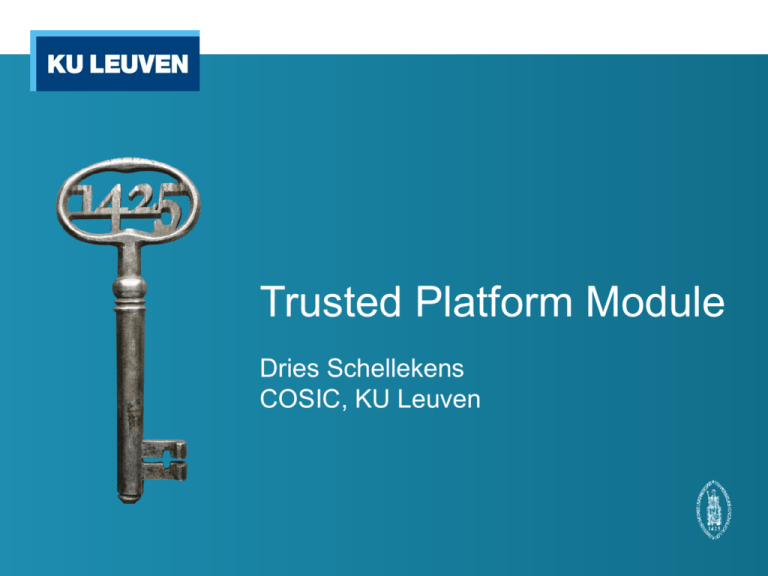
Trusted Platform Module Dries Schellekens COSIC, KU Leuven Nomenclature Trusted versus trustworthy RFC 4949 (Internet Security Glossary) • Trust: A feeling of certainty (sometimes based on inconclusive evidence) either (a) that the system will not fail or (b) that the system meets its specifications (i.e., that system does what it claims to do and does not perform unwanted functions). • Trusted system: A system that operates as expected according to design and policy, doing what is required – despite environmental disruption, human user and operator errors, and attacks by hostile parties – and not doing other things. • Trustworthy system: A system that not only is trusted, but also warrants that trust because the system’s behavior can be validated in some convincing way, such as through formal analysis or code review. Trusted Platform Module, Dries Schellekens, COSIC Slide 3 Alternative definitions • NSA definition Trusted: System or component whose failure can break the security policy. (TCB = Trusted Computing Base) o Trustworthy: System or component that will not fail with respect to the security policy. • TCG definition o “An entity can be trusted if it always behaves in the expected manner for the intended purpose.” • Some people now regret the name Trusted Computing o Trustworthy Computing or maybe Trustable Computing could be a better title, but it is too late to change. o Trusted Platform Module, Dries Schellekens, COSIC Slide 4 Motivation Establish trustworthiness in distributed IT systems Classic attacks on online banking • Attack on network communication transfer €50 to Pela transfer €10000 to Criminal • Impersonation attack transfer €10000 to Criminal Trusted Platform Module, Dries Schellekens, COSIC Slide 6 Modern attacks on online banking • Phishing attack transfer €50 to Bob transfer €1000 to Criminal • Man-in-the-browser attack transfer €50 to Bob Trusted Platform Module, Dries Schellekens, COSIC transfer €1000 to Criminal Slide 7 Trusted Computing to the rescue • Trusted computing platforms support o o Verification of software executing on remote platform Binding of data to specific platform state • Applications o o o o o Online banking Multiplayer game Remote access to corporate network Digital/Enterprise rights management … Trusted Platform Module, Dries Schellekens, COSIC Slide 8 Milestones of Trusted Computing 1999 Feb. 2002 April 2003 Oct. 2003 2006 Trusted Computing Platform Alliance (TCPA) founded by Trusted Platform Module (TPM) 1.1b specification published (TCG) formed as successor for TCPA TPM 1.2 specification published 20+ million TPMs sold Jan. 2007 TPM supported by BitLocker drive encryption in June 2007 Mobile Trusted Module (MTM) 1.0 specification published May 2009 TPM 1.2 specification adopted as ISO/IEC 11889 standard 2011 Oct. 2012 March 2013 500+ million TPMs sold Improved TPM support in TPM 2.0 library specification published Trusted Platform Module, Dries Schellekens, COSIC Slide 9 Technical overview TCG components • Core Root of Trust for Measurement (CRTM) Immutable software component that executes upon a host platform reset o Platform dependent: BIOS for PC and EFI for Server • Trusted Platform Module (TPM) o Hardware component that provides a set of fixed cryptographic and security functions o (Originally) intended to be platform agnostic • Trusted Software Stack (TSS) o Issues low-level TPM commands and receives low-level TPM responses on behalf of high-level applications o Trusted Platform Module, Dries Schellekens, COSIC Slide 11 Core Root of Trust for Measurement • Immutable portion of the host platform’s initialization code that is executed upon a host platform reset • Trust in measurement of platform configuration is based on the integrity of the CRTM • On PC platform o CRTM = BIOS boot block • Rest of BIOS is measured in authenticated boot process o CRTM = Entire BIOS • BIOS Flash memory must be protected against unauthorized reprogramming • TCG has specifications for o o Conventional BIOS EFI (Extensible Firmware Interface) BIOS Trusted Platform Module, Dries Schellekens, COSIC Slide 12 Trusted Platform Module • Design goals: Simple, thus cheap (< $1) and hopefully free of bugs o Low performance (no crypto accelerator) • Smartcard like cryptographic coprocessor o Small set of cryptographic functions o • Key generation, signing, encryption (RSA), hashing (SHA-1), HMAC Hardware random number generator (RNG) • Additional features o Authenticated boot (integrity measurement) o Remote attestation (integrity reporting) o Sealed storage • Securely bound to the rest of the platform • 500+ million TPMs (mainly 1.2) sold today o Trusted Platform Module, Dries Schellekens, COSIC Slide 13 TPM hardware architecture EEPROM SRAM µC ROM RSA Chip layout of Infineon TPM 1.2 Christopher Tarnovsky (Black Hat 2010) Trusted Platform Module, Dries Schellekens, COSIC Slide 14 TPM hardware architecture • Microcontroller (µC) with RSA coprocessor and RNG • ROM: Firmware for microcontroller SHA-1 and HMAC typically in software SRAM: Volatile memory o Key slots: load external keys o Platform Configuration Registers (PCR): store integrity measurements (24 x 160 bit) EEPROM: Non-volatile memory o Endorsement Key (EK) uniquely identifies TPM o Storage Root Key (SRK) encrypts other keys maintained by TPM o Owner’s authorization data (password) o Monotonic counters (4 x 32 bit) o NVRAM: small amount of freely programmable memory I/O interface o PC Client: Low-Pin Count (LPC) bus o Embedded: I2C or System Management Bus (SMBus) o • • • Trusted Platform Module, Dries Schellekens, COSIC Slide 15 TPM BIOS Flash Trusted Platform Module, Dries Schellekens, COSIC Expansion Cards Super I/O I/O Controller Hub (ICH) USB Devices LPC Network Interface Hard Disk Parallel Port Serial Port PS/2 Floppy Integration of TPM into PC platform Graphics Controller Graphics Memory Controller Hub (GMCH) FSB Central Processing Unit (CPU) System Memory LPC = Low Pin Count FSB = Front Side Bus Slide 16 TCG functionality • Authenticated boot Logging of boot sequence Remote attestation o Report boot sequence to third party User management o Balance the interest of different parties (user, owner, …) Key management o Maintain cryptographic keys and control usage/access o Sealed storage: restrict access based on specific boot sequence Other features o RNG, clock, monotonic counter, … o • • • • Trusted Platform Module, Dries Schellekens, COSIC Slide 17 Authenticated boot • Synonym: measured boot or trusted boot • Transitive chain of trust CRTM 3 1 BIOS 4 Boot Loader Operating System Application 2 TPM SML PCR 12 65 0 49 98 MBIOS MBL MOS MApp 1. “Measure” integrity of next component MX = Hash(X) 2. Store measurement value MX in SML 3. Extend measurement value MX in PCR PCRnew = Hash(PCRold, MX) 4. Execute/pass control to next component PCR = Platform Configuration Register SML = Stored Measurement Log Trusted Platform Module, Dries Schellekens, COSIC Slide 18 Difference with secure boot • Secure boot Boot process is halted when untrusted software is loaded o Only execute code that is signed by the device manufacturer or a certified software vendor o Examples: game consoles, smart phones, TV settop box • Authenticated boot o TPM is passive and only records the boot process o Platform can still load arbitrary software, like with a traditional open platform (e.g., PC) o Enforcement of “good” configurations has to be done separately o • Remote attestation is used to grant/deny access to network service • Sealed storage is used to grant/deny access to locally stored secret • Warning: UEFI Secure Boot is coming to PC with Windows 8 Trusted Platform Module, Dries Schellekens, COSIC Slide 19 Remote attestation • Remote attestation: challenge-response protocol nonce certAIK, SignAIK(nonce, PCR), SML Verifier • TPM identities o o Endorsement Key (EK): uniquely identifies TPM Attestation Identity Key (AIK): pseudonym CertEK, AIK EncEK(certAIK) Privacy CA Trusted Platform Module, Dries Schellekens, COSIC Slide 20 Direct anonymous attestation (DAA) • TPM may have multiple AIKs Best case: different AIK for every service provider • Practical issues with Privacy CA o Trusted third party is hard to find and expensive to maintain o Evidence: no commercial privacy CA at the moment o Privacy CA can link pseudonyms • TPM 1.2 defines alternative solution to certify AIKs o Direct Anonymous Attestation: zero knowledge protocol o • Unlinkability of TPM transactions • No privacy CA needed o TPMs can only be recognized if • Their internal DAA secrets are exposed • They try to identify too often in a short period Trusted Platform Module, Dries Schellekens, COSIC Slide 21 Key management • Non-volatile memory of TPM is limited in size • TPM only stores two permanent cryptographic keys o Endorsement Key (EK): unique RSA en-/decryption key • • • • o Private key never leaves TPM Public key is privacy sensitive (identifies a TPM) Generated during manufacturing process of TPM Some TPM manufacturers (Infineon, STM) provide endorsement certificate on the EK Storage Root Key (SRK): RSA en-/decryption key • • • • Root of key hierarchy maintained by TPM Private key never leaves TPM Generated by TPM when ownership is taken Deleted when TPM owner is deleted Trusted Platform Module, Dries Schellekens, COSIC Slide 22 TPM key hierarchy TPM EK • Unlimited amount of keys SRK External storage AIK SignK AIK StorK BindK StorK SignK BindK SymK File SymK File File can be stored externally • Storage keys (StorK) protect other key types • Attestation ID keys (AIK) • Binding keys (BindK) • Signing keys (SignK) • Symmetric keys (SymK) • All keys and data (i.e., files) indirectly protected by SRK • External TPM keys must be loaded in a key slot by the TSS before they can be used Trusted Platform Module, Dries Schellekens, COSIC Slide 23 Key types and attributes • Most important key types o Attestation identity keys: used for remote attestation • Pseudonyms for EK o o o Binding keys: encrypt secret data (e.g., symmetric key) Signing key: sign arbitrary data Storage keys: protect other keys outside of TPM • Inner nodes of key hierarchy • Key attributes o o o Password protected Migratable, non-migratable, or certified Bound to specific PCR value (known as sealed storage) Trusted Platform Module, Dries Schellekens, COSIC Slide 24 User management • Access to certain operations/keys requires authentication • Two ways to authenticate to the TPM o o Asserting Physical Presence: Proof that one has physical access to the platform through BIOS setting or hardware switch Using Authentication Protocols: Proof that one knows an authentication secret (= hash of passphrase) • Mitigation techniques to prevent online dictionary attacks • Distinction between user and owner of platform Corporate setting: IT department owns the platform o Home environment: user and owner are the same entity • TPM only becomes fully functional after “take ownership” command o Owner sets owner authentication secret (encrypted with EK) o This command clears the TPM and generates new SRK o Trusted Platform Module, Dries Schellekens, COSIC Slide 25 Beyond TPMs Problem statement transfer €50 to Bob transfer €1000 to Criminal • Applications Online banking: honest user, but malware present o Multiplayer game: dishonest user o Remote access to corporate network o Digital rights management: dishonest user o Enterprise rights management • Does TC enable to remotely detect man-in-the-browser? o Yes, but … o Trusted Platform Module, Dries Schellekens, COSIC Slide 27 Shortcomings of TCG attestation • Criticism on TCG attestation Privacy issue: verifier gets too detailed information o Risk for discrimination of certain platforms (e.g., Linux) Attestation of individual programs is challenging o What should be measured? Executable image, shared libraries, sensitive arguments, configuration files, … Scalability issues o Measurement log can become very long o • • • Windows loads 200+ drivers from known set of 4+ million • IMA records 3000+ measurements on default Linux desktop Verifier must maintain large database of possible configurations Time-of-Check Time-of-Use problem o Runtime compromise using security vulnerability after integrity measurement Trustworthiness of platform must be improved with other security mechanisms; e.g., malware detection, microkernel, virtualization, safe programming language, trusted execution environment, …. o • • Trusted Platform Module, Dries Schellekens, COSIC Slide 28 Concept of trusted virtualization layer • In a nutshell o Hypervisor/virtual machine monitor isolates multiple virtual machines (VM) • VM for untrustworthy legacy OS, where • VM with stripped-down secure OS that host the critical application (e.g., DRM client, game, email client, …) Remote attestation is used to verify the hypervisor o Hypervisor reports security policy and/or integrity of secure VM • More scalable because the image of secure VM does not depend on the underlying hardware • Performance overhead is limited on processors with virtualization extensions • Proof-of-concept implementation by OpenTC project o Trusted Platform Module, Dries Schellekens, COSIC Slide 29 Dynamic Root of Trust for Measurement • Hardware virtualization support was added to x86 architecture • Intel TXT and AMD SVM provide late launch functionality Ability to start hypervisor after legacy operating system has booted o Integrity of hypervisor can be measured and recorded in the TPM using a special processor instruction (SENTER/SKINIT) o This special instruction can reset certain PCRs with special LPC bus cycles • In theory: legacy components such as BIOS, bootloader, … must no longer be trusted, hence reducing the TCB considerably • In practice: DRTM has been attacked with System Management Mode (SMM) code o Trusted Platform Module, Dries Schellekens, COSIC Slide 30 Executive summary • TCG introduced the concept of authenticated boot and remote attestation as alternative for traditional, code signing-based secure boot • TPM is the hardware component in a trusted computing platform, but software support (CRTM + TSS) is needed as well • TC is only an enabling technology, but without a trustworthy operating system it is rather useless o The addition of a TPM does not automagically make a platform more secure • Practical deployment of TC technology is more challenging than expected o 500+ million TPMs have been sold, but most are rarely used o Best known TPM application: Microsoft Bitlocker disk encryption o Windows 8 has much more extensive TPM support (including authenticated boot process) than previous versions Trusted Platform Module, Dries Schellekens, COSIC Slide 31 Main changes in TPM 2.0 • More flexible command set TPM 1.2 specification was focused on PC(-like) platform. o Dedicated MTM specification was needed for mobile phone, making mandatory TPM 1.2 features optional. o TPM 2.0 is “library specification” that will be used as the basis for the creation of platform-specific TPM specifications. • Algorithm agility o TPM 1.x: only RSA and SHA-1 o TPM 2.0: addition of elliptic curve-based crypto, AES, SHA-2, Whirlpool • A bit more from everything: multiple banks of PCRs, multiple EKs and SRKs, more flexible/fine-grained authorization • Reference implementation in C available o Trusted Platform Module, Dries Schellekens, COSIC Slide 32 Additional reading material • http://www.trustedcomputinggroup.org • Books Trusted Platform Module, Dries Schellekens, COSIC Slide 33
